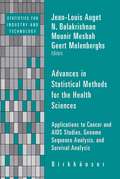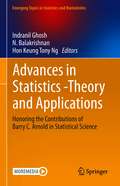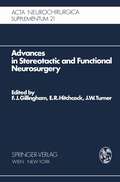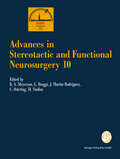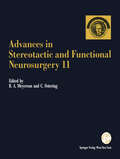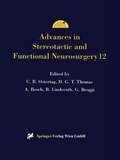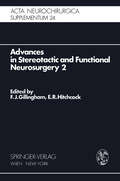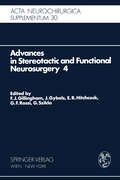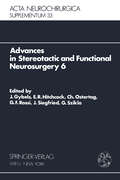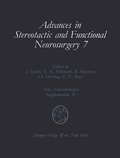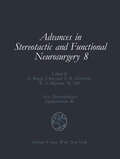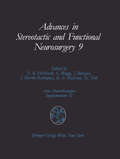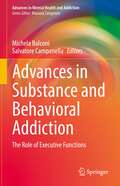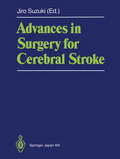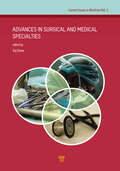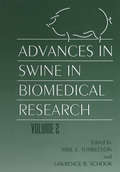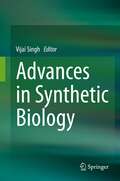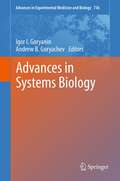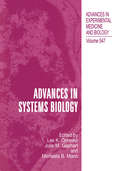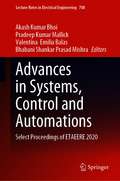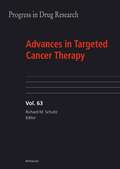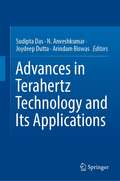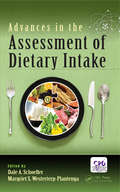- Table View
- List View
Advances in Statistical Methods for the Health Sciences: Applications to Cancer and AIDS Studies, Genome Sequence Analysis, and Survival Analysis (Statistics for Industry and Technology)
by Jean-Louis Auget N. Balakrishnan Mounir Mesbah Geert MolenberghsStatistical methods have become an increasingly important and integral part of research in the health sciences. Many sophisticated methodologies have been developed for specific applications and problems. This self-contained comprehensive volume covers a wide range of topics pertaining to new statistical methods in the health sciences, including epidemiology, pharmacovigilance, quality of life, survival analysis, and genomics. The book will serve the health science community as well as practitioners, researchers, and graduate students in applied probability, statistics, and biostatistics.
Advances in Statistics - Theory and Applications: Honoring the Contributions of Barry C. Arnold in Statistical Science (Emerging Topics in Statistics and Biostatistics)
by Indranil Ghosh N. Balakrishnan Hon Keung Tony NgThis edited collection brings together internationally recognized experts in a range of areas of statistical science to honor the contributions of the distinguished statistician, Barry C. Arnold. A pioneering scholar and professor of statistics at the University of California, Riverside, Dr. Arnold has made exceptional advancements in different areas of probability, statistics, and biostatistics, especially in the areas of distribution theory, order statistics, and statistical inference. As a tribute to his work, this book presents novel developments in the field, as well as practical applications and potential future directions in research and industry. It will be of interest to graduate students and researchers in probability, statistics, and biostatistics, as well as practitioners and technicians in the social sciences, economics, engineering, and medical sciences.
Advances in Stereotactic and Functional Neurosurgery: Proceedings of the 1st Meeting of the European Society for Stereotactic and Functional Neurosurgery, Edinburgh 1972 (Acta Neurochirurgica Supplement #21)
by F. John Gillingham E. R. Hitchcock J. W. TurnerAdvances in Stereotactic and Functional Neurosurgery 10: Proceedings of the 10th Meeting of the European Society for Stereotactic and Functional Neurosurgery Stockholm 1992 (Acta Neurochirurgica Supplement #58)
by Assoc. Professor Dr. Björn A. Meyerson Professor Dr. Giovanni Broggi Professor Dr. Jose Martin-Rodriguez Professor Dr. Christoph Ostertag Professor Dr. Marc SindouThese proceedings from the Xth Congress of the European Society for Stereotactic and Functional Neurosurgery in Stockholm reflect the growing interest in these fields of neurosurgery. It is the most extensive volume in this series of publications and it contains a large number of original articles pertaining to the most recent advances in stereotactic and functional neurosurgery. Not long ago stereotactic neurosurgery was considered an esoteric sub speciality practised only by those involved in treating movement disorders and pain. In the last decade we have witnessed the incorporation of stereotactic methodology in the management of common neurosurgical diseases, and the stereotactic technique is now practised in all major neurosurgical centers. As with other surgical techniques and tools, however, the utilization of stereotactic methods requires special knowledge and training. This book comprises articles which give insight into new stereotactic applications and technology. For example, the usage of stereotaxis without a frame and the so-called navigator systems in open tumor surgery is dealt with in two papers. The introduction and development of radiosurgery is closely linked to the advancement of stereotactic technique. Radiosurgical treatment of tumors and cerebrovascular diseases has been one of major achievements in modern neurosurgery. This publication contains several original reports illustrating the efficacy of radiosurgery in problematic neurosurgical diseases.
Advances in Stereotactic and Functional Neurosurgery 11: Proceedings of the 11th Meeting of the European Society for Stereotactic and Functional Neurosurgery, Antalya 1994 (Acta Neurochirurgica Supplement #64)
by Björn A. Meyerson and Christoph OstertagThis volume contains selected contributions from the XIth Meeting of the European Society for Stereotactic and Functional Neurosurgery held in September 1994 in Antalyaffurkey. Most of the papers deal with the many therapeutic and technical advancements made in this field of neurosurgery. The emergence of new stereotactic methodologies such as frameless stereotaxy and other forms of neuronavigation have become an indispensable tool for all types of neurosurgical operations. An increasing number of young neurosurgeons takes an interest in the neurosurgical approaches to the treatment of movement disorders, chronic pain and epilepsy. This is a clear sign ofthe growing awareness of the long neglected fact that these neurosurgical treatments can be offered to large patient populations. Neurotransplantation as a novel treatment of Parkinson's disease has paved the way for the application of this technology for other indications. The pioneering work performed by the late Edward Hitchcock is reviewed here. There is a renewed interest in pallidotomy for dealing with certain forms of Parkinson's disease and certain aspects of this operation are discussed in another paper. Progress in the neurosurgical treatment of pain is dealt with by contributions on refined techniques of percutaneous cordotomy, DREZ operations and critical evaluations of spinal cord stimulation. A novel approach is a report on the experiences of treating cancer pain by intraspinal implantation of chromaffin cells. Several contributions cover the important issues of novel techniques for the study of neural dysfunction, peroperative monitoring with PET, microrecording, magneto-encephalography and other techniques.
Advances in Stereotactic and Functional Neurosurgery 12: Proceedings of the 12th Meeting of the European Society for Stereotactic and Functional Neurosurgery, Milan 1996 (Acta Neurochirurgica Supplement #68)
by C. B. Ostertag, D. G. T. Thomas, A. Bosch, B. Linderoth and G. BroggiNeurosurgery o/the Future: Computers and Robots in Clinical Neurosurgical Practice and in Training - a Philosophical Journey into the Future Many present day neurosurgeons believe that they already obtain good results in operative surgery with the benefit of the operating microscope and other aids which have become available in the last three decades and that the introduction of computers and robots to the operating theatre is superfluous. However, it is clear from analogy with the function of the airline pilot, another profession where there are great demands on manual skill and on spatial awareness, that these devices do have much to offer neurosurgery. Classical neurosurgery, in the time of Cushing, Dandy and Scarff, was based on a three dimensional picture of the patient's brain formed in the surgeon's mind and often illustrated in elegant drawings. Such pictures were based on neuroradiological studies by pneumoencephalography, ventriculography or by angiography. Generally these stud ies showed the presence and position of a lesion by displacement of normal brain structures and the picture was built up by interference. This was then converted by the experienced neurosurgeon into a plan for the craniotomy site and the trajectory of the surgical approach. Once the brain was exposed further pre-operative information was obtained by visual inspection and by palpation with the brain needle. These classical forms ofneuroradiology have largely been superseded by computerised tomography and by magnetic resonance imaging.
Advances in Stereotactic and Functional Neurosurgery 2: Proceedings of the 2nd Meeting of the European Society for Stereotactic and Functional Neurosurgery, Madrid 1975 (Acta Neurochirurgica Supplement #24)
by F. John Gillingham Edward R. HitchcockAdvances in Stereotactic and Functional Neurosurgery 4: Proceedings of the 4th Meeting of the European Society for Stereotactic and Functional Neurosurgery, Paris 1979 (Acta Neurochirurgica Supplement #30)
by F. John Gillingham, Jan Gybels, Edward Hitchcock, Gian Franco Rossi and Gábor SziklaAdvances in Stereotactic and Functional Neurosurgery 6: Proceedings of the 6th Meeting of the European Society for Stereotactic and Functional Neurosurgery, Rome 1983 (Acta Neurochirurgica Supplement #33)
by J. Gybels E. R. Hitchcock C. Ostertag G. F. Rossi J. Siegfried G. SziklaLocal interstitial radiation therapy of intrinsic and inaccessible brain tumors is confronted with two major problems: 1. The tolerance of normal brain tissue, which is usually involved in local tumor irradiation, i.e. perifocal white matter edema and demyelinating effects, is crucial. 2. Data on radiation effects of implanted radioactive sources on neoplastic tissue, i.e. data on the radiosensitivity and on the biology of tumors, are still widely unavailable. In clinical practice the dose with which to achieve a given volume of tumor necrosis is roughly estimated. This report deals with the experimental findings of Iodine-125 and Iridium-I92 permanent implants in healthy and neoplastic brain tissue. Our own experimental findings are correlated with experimental data on Yttnul11-l)O irradiation from the literature. The study is directed to collect data on the tolerance non-tumoral brain tissue and to attempt to establish a dose-response relationship. Morphologic Changes in the Dog Brain Following Interstitial Iodine-125 Irradiation Iodine-I25 seeds (manufactured by 3 M Company, St. Paul, M. N.) with an activity of 3.55 mCi were permanently implanted under stereotactic conditions into the subcortical white matter of the gyrus coronalis of the left hemisphere in 6 beagle dogs. One animal with a non-radioactive seed implanted under similar operative conditions served as a control. The animals were allowed to survive 25, 46, 71, 94, 248, 368 days, respectively, after the implantation. The control animal survived 46 days. A detailed description of the experimental procedure is given elsewhere 16. 17.
Advances in Stereotactic and Functional Neurosurgery 7: Proceedings of the 7th Meeting of the European Society for Stereotactic and Functional Neurosurgery, Birmingham 1986 (Acta Neurochirurgica Supplement #39)
by J. Gybels, E. R. Hitchcock, B. Mryerson, Ch. Ostertag, G. F. RossiAdvances in Stereotactic and Functional Neurosurgery 8: Proceedings of the 8th Meeting of the European Society for Stereotactic and Functional Neurosurgery, Budapest 1988 (Acta Neurochirurgica Supplement #46)
by SzabolcsTóth Björn A. Meyerson Edward R. Hitchcock JuanBurzaco GiovanniBroggiThe last ten years has witnessed a resurgence of interest in stereotactic surgery although this has been mainly in the field of the comparatively simple stereotactic biopsy of intracranial tumours. There is also evidence of a returning interest in functional neurosurgery other than pain which has always sustained high levels of endeavour. The present work comprises selected papers from a much larger group of interesting and important communications to the European Society for Stereotactic and Functional Neurosurgery. They represent modern views on a wide variety of stereotactic surgical topics from internationally acclaimed experts in this field. The neurosurgeon who has little or no acquaintance with this fruitful sub-specialty will be surprised to find very broad applications of the technique which is gradually replacing many con ventional neurosurgical procedures. This is particularly evident in the papers on tumours but there is also a section on the treatment of vascular disease which marks an extension of neurosurgical practice. The Society has always regarded technical advances as important and some of the most recent devel opments appear in this book. Finally, an exciting new development of neural transplantation marks the beginning of what may be an important part of neurological surgery in the future.
Advances in Stereotactic and Functional Neurosurgery 9: Proceedings of the 9th Meeting of the European Society for Stereotactic and Functional Neurosurgery, Malaga 1990 (Acta Neurochirurgica Supplement #52)
by Szabolcs Tóth Björn A. Meyerson J. Martin-Rodriguez Juan Burzaco Giovanni Broggi Edward R. HitchcockThe book gives the most up-to-date information for the expanding field of stereotactic and functional neurosurgery from European and international experts. The newest developments in neural transplantation and stereotactic irradiation are included together with the reports on extensive trials of analgesic surgery and new techniques used in the treatment of a variety of functional disorders.
Advances in Substance and Behavioral Addiction: The Role of Executive Functions (Advances in Mental Health and Addiction)
by Michela Balconi Salvatore CampanellaThis book deals with recent perspectives on the panel of addiction behavior in a vast amount of population (young and adult). Thanks to the contribution of experts of the topic of addiction the volume will furnish new perspectives to formulate assessment, diagnosis and intervention in response to the increasing variety of addictions. It focuses the assessment of executive functions in substance and behavioral addictions. More specifically, this assessment consists of a new approach not only inherent to the diagnosis, but also to the treatment and prevention of addictions. In fact, there is a strict relationship between executive functions (EF) and addictive behavior: EF plays a remarkable role in significant phenomena for the treatment of addictions, such as craving, relapse and compliance to treatment.
Advances in Surgery for Cerebral Stroke: Proceedings of the International Symposium on Surgery for Cerebral Stroke, Sendai 1987
by Jiro SuzukiCerebral stroke is a common and widespread phenomenon affecting a large number of the human population worldwide. Various surgical methods have been developed for its treatment and the therapeutic results have steadily improved. This is a reassuring trend that promises further progress will be made in the future. This volume contains important contributions by leading clinicians and researchers in the field to the "International Symposium on Surgery for Cerebral Stroke" held in Sendai, Japan, May 24 - 27, 1987.
Advances in Surgical and Medical Specialties
by Raj BawaThe pace and sophistication of advances in medicine in the past two decades have been truly breathtaking. This has necessitated a growing need for comprehensive references that highlight the current issues in specific sectors of medicine. Keeping this in mind, each volume in the Current Issues in Medicine series is a stand‐alone text that provides a broad survey of various critical topics in a focused area of medicine—all accomplished in a user-friendly yet interconnected format. However, unlike other series on medicine or medical texts, this series focuses on current trends, perspectives, and issues in medicine that are central to healthcare delivery in the 21st century. Medical practitioners today continue to improve upon techniques and technologies to provide procedures for patients that are safer, faster, less invasive, and more accurate —a direct consequence of advances in technological breakthroughs from a variety of medical and engineering fields. In order to render modern patient care, it is imperative that surgeons and medical practitioners stay current with these latest advances in their respective specialties. Given this backdrop, the specific topics covered in this volume and the expertise of the contributing authors accurately reflect the rapidly evolving areas within surgical and medical specialties. While recognising how expansive and multifaceted medicine is, Advances in Surgical and Medical Specialties addresses crucial recent advances in surgical and medical specialties, intergrating the knowledge and experience of experts from academia and practicing surgeons. The multidisciplinary approach reflected here makes this volume a valuable reference resource for medical practictioners, medical students, nurses, fellows, residents, undergraduate and graduate students, educators, venture capitalists, policymakers, and biomedical researchers. A wide audience will benefit from having this volume on their bookshelf: health care systems, the pharmaceutical industry, academia, and government.
Advances in Surgical and Medical Specialties
The pace and sophistication of advances in medicine in the past two decades have been truly breathtaking. This has necessitated a growing need for comprehensive references that highlight the current issues in specific sectors of medicine. Keeping this in mind, each volume in the Current Issues in Medicine series is a stand‐alone text that provides a broad survey of various critical topics in a focused area of medicine—all accomplished in a user-friendly yet interconnected format. However, unlike other series on medicine or medical texts, this series focuses on current trends, perspectives, and issues in medicine that are central to healthcare delivery in the 21st century. Medical practitioners today continue to improve upon techniques and technologies to provide procedures for patients that are safer, faster, less invasive, and more accurate —a direct consequence of advances in technological breakthroughs from a variety of medical and engineering fields. In order to render modern patient care, it is imperative that surgeons and medical practitioners stay current with these latest advances in their respective specialties. Given this backdrop, the specific topics covered in this volume and the expertise of the contributing authors accurately reflect the rapidly evolving areas within surgical and medical specialties. While recognising how expansive and multifaceted medicine is, Advances in Surgical and Medical Specialties addresses crucial recent advances in surgical and medical specialties, intergrating the knowledge and experience of experts from academia and practicing surgeons. The multidisciplinary approach reflected here makes this volume a valuable reference resource for medical practictioners, medical students, nurses, fellows, residents, undergraduate and graduate students, educators, venture capitalists, policymakers, and biomedical researchers. A wide audience will benefit from having this volume on their bookshelf: health care systems, the pharmaceutical industry, academia, and government.
Advances in Swine in Biomedical Research: Volume 2
by Lawrence B. Schook and Mike E. TumblesonSimilarities in structure and function between pigs and human beings include size, feeding patterns, digestive physiology, dietary habits, kidney structure and function, pulmo nary vascular bed structure, coronary artery distribution, propensity to obesity, respiratory rates, tidal volumes and social behaviors. Since the pig is an omnivore, it provides an adaptable model to evaluate chronic and acute exposures to xenobiotics such as alcohoL caffeine, tobacco, food additives and environmental pollutants. Swine have been used successfully as models to evaluate alcoholism, diabetes, absorption, digestion, total paren teral nutrition, organ transplantation, atherosclerosis, exercise, hypertension. hemorrhagic hypotension, melanoma, gingivitis, obstructive and reflux nephropathy. osteochondrosis. dermal healing and septic shock. A severe and worsening shortage of organs and tissues for transplantation in patients with severe organ failure has encouraged the consideration of inter species or xenotransplan tation. In developing programs toward this end, the pig generally is viewed as the preferred donor because of its size, physiology and availability. The pig harbors relatively few diseases which could be transmitted inadvertently to human patients. The ability to genetically modify swine to ameliorate the consequences of the human immune response offers a further significant advantage. Another important consideration for an animal model is that basic biologic back ground information be available for investigators to design future prospective studies.
Advances in Synthetic Biology
by Vijai SinghThis book addresses the design of emerging conceptual tools, technologies and systems including novel synthetic parts, devices, circuits, oscillators, biological gates, and small regulatory RNAs (riboregulators and riboswitches), which serve as versatile control elements for regulating gene expression. Synthetic biology, a rapidly growing field that involves the application of engineering principles in biology, is now being used to develop novel systems for a wide range of applications including diagnostics, cell reprogramming, therapeutics, enzymes, vaccines, biomaterials, biofuels, fine chemicals and many more. The book subsequently summarizes recent developments in technologies for assembling synthetic genomes, minimal genomes, synthetic biology toolboxes, CRISPR-Cas systems, cell-free protein synthesis systems and microfluidics. Accordingly, it offers a valuable resource not only for beginners in synthetic biology, but also for researchers, students, scientists, clinicians, stakeholders and policymakers interested in the potential held by synthetic biology.
Advances in Systems Biology (Advances in Experimental Medicine and Biology #736)
by Igor I. Goryanin and Andrew B. GoryachevThe International Society for Systems Biology (ISSB) is a society aimed at advancing world-wide systems biology research by providing a forum for scientific discussions and various academic services. The ISSB helps coordinate researchers to form alliances for meeting the unique needs of multidisciplinary and international systems biology research. The annual International Conference on Systems Biology (ICSB) serves as the main meeting for the society and is one of the largest academic and commercial gatherings under the broad heading of ‘Systems Biology’.
Advances in Systems Biology (Advances in Experimental Medicine and Biology #547)
by Lee K. Opresko Julie M. Gephart Michaela B. MannAdvances in Systems, Control and Automations: Select Proceedings of ETAEERE 2020 (Lecture Notes in Electrical Engineering #708)
by Akash Kumar Bhoi Pradeep Kumar Mallick Valentina Emilia Balas Bhabani Shankar Prasad MishraThis book comprises select proceedings of the international conference ETAEERE 2020. This volume covers latest research in advanced approaches in automation, control based devices, and adaptive learning mechanisms. The contents discuss the complex operations and behaviors of different systems or machines in different environments. Some of the areas covered include control of linear and nonlinear systems, intelligent systems, stochastic control, knowledge-based systems applications, fault diagnosis and tolerant control, and real-time control applications. The contents of this volume can be useful for researchers as well as professionals working in control and automation.
Advances in Terahertz Technology and Its Applications
by Sudipta Das N. Anveshkumar Joydeep Dutta Arindam BiswasThis book highlights the growing applications of THz technology and various modules used for their successful realization. The enormous advantages of THz devices like higher resolution, spatial directivity, high-speed communication, greater bandwidth, non-ionizing signal nature and compactness make them useful in various applications like communication, sensing, security, safety, spectroscopy, manufacturing, bio-medical, agriculture, imaging, etc. Since the THz radiation covers frequencies from 0.1THz to around 10THz and highly attenuated by atmospheric gases, they are used in short-distance applications only. The book focuses on recent advances and different research issues in terahertz technology and presents theoretical, methodological, well-established and validated empirical works dealing with the different topics.
Advances in the Assessment of Dietary Intake.
by Dale A. Schoeller M. WesterterpDiet is a major factor in health and disease. Controlled, long-term studies in humans are impractical, and investigators have utilized long-term epidemiological investigations to study the contributions of diet to the human condition. Such studies, while valuable, have often been limited by contradictory findings; a limitation secondary to systematic errors in traditional self-reported dietary assessment tools that limit the percentage of variances in diseases explained by diet. New approaches are available to help overcome these limitations, and Advances in the Assessment of Dietary Intake is focused on these advances in an effort to provide more accurate dietary data to understand human health. Chapters cover the benefits and limitations of traditional self-report tools; strategies for improving the validity of dietary recall and food recording methods; objective methods to assess food and nutrient intake; assessment of timing and meal patterns using glucose sensors; and physical activity patterns using validated accelerometers. Advances in the Assessment of Dietary Intake describes new avenues to investigate the role of diet in human health and serves as the most up-to-date reference and teaching tool for these methods that will improve the accuracy of dietary assessment and lay the ground work for future studies.
Advances in the Assessment of Dietary Intake.
by Dale A. Schoeller M. WesterterpDiet is a major factor in health and disease. Controlled, long-term studies in humans are impractical, and investigators have utilized long-term epidemiological investigations to study the contributions of diet to the human condition. Such studies, while valuable, have often been limited by contradictory findings; a limitation secondary to systematic errors in traditional self-reported dietary assessment tools that limit the percentage of variances in diseases explained by diet. New approaches are available to help overcome these limitations, and Advances in the Assessment of Dietary Intake is focused on these advances in an effort to provide more accurate dietary data to understand human health. Chapters cover the benefits and limitations of traditional self-report tools; strategies for improving the validity of dietary recall and food recording methods; objective methods to assess food and nutrient intake; assessment of timing and meal patterns using glucose sensors; and physical activity patterns using validated accelerometers. Advances in the Assessment of Dietary Intake describes new avenues to investigate the role of diet in human health and serves as the most up-to-date reference and teaching tool for these methods that will improve the accuracy of dietary assessment and lay the ground work for future studies.
